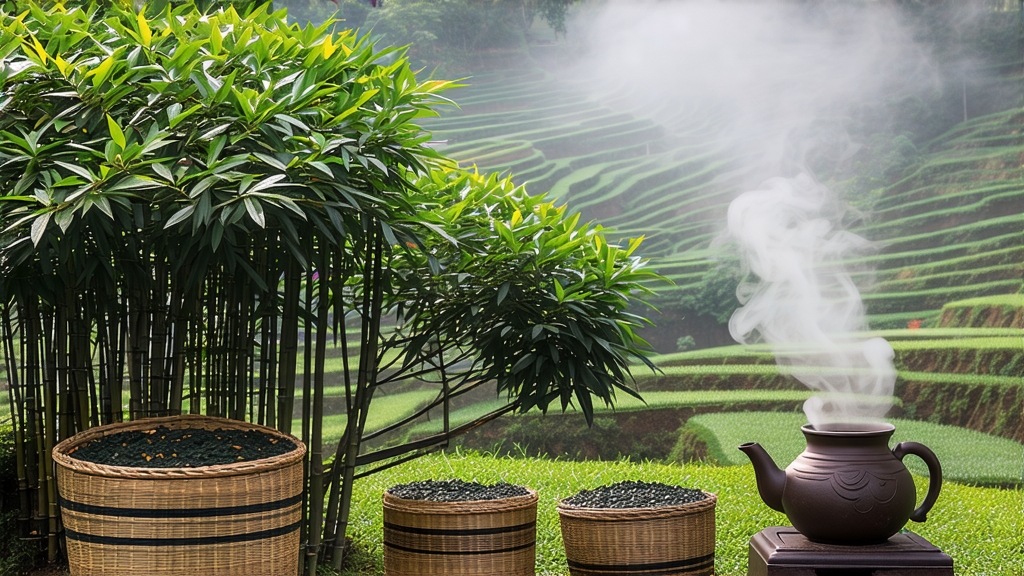
Tucked away in the subtropical hills of southern China, Liu Bao tea has spent centuries perfecting the art of quiet transformation. To the casual observer it is merely another dark, earthy brick; to the initiated it is a living archive of microbes, climate, and human patience. International drinkers who know Pu-erh often overlook Liu Bao, yet this Guangxi specialty predates many famous puer cakes and carries its own elegant story of war caravans, river dampness, and timeless cellars. This article invites you to travel the trade route that once began at the port of Wuzhou and ends, today, in your own teapot.
-
Historical footprints
Liu Bao takes its name from the old Liu Bao township in Cangwu County, Guangxi Zhuang Autonomous Region. During the Qing dynasty, pressed baskets of this dark tea were loaded onto bamboo rafts, floated down the Xun River to the Pearl River delta, and then shipped to Hong Kong and Southeast Asia where miners and dockworkers prized it for “cutting the grease” of heavy cuisine. In 1802 the Jiaqing Emperor reportedly granted Liu Bao the honorary title of “gong cha” (tribute tea), cementing its reputation at court. When the British opened Hong Kong as a free port, Liu Bao traveled farther—reaching Malaya, Singapore, and even Calcutta—where it was often blended with spices to create early “teh tarik” prototypes. Thus, while Pu-erh dominated the Tea Horse Road westward, Liu Bao sailed the maritime silk road southward, absorbing humidity and sea salt on the voyage, factors that would later influence its unique aging chemistry. -
Terroir and leaf
Guangxi’s karst hills trap morning fog, bathing tea gardens in diffused light and raising annual humidity above 80 %. The indigenous large-leaf variety, Camellia sinensis var. assamica cv. Guangxi, develops thick cell walls rich in polyphenols and pectin—ideal substrates for microbial fermentation. Soils are lateritic, iron-rich and slightly acidic, yielding leaf that is sturdy yet subtly fragrant, reminiscent of raw cacao and dried longan. Farmers traditionally intercrop tea with cinnamon, star anise and pomelo, believing that aromatic neighbors perfume the leaf long before harvest. -
Crafting Liu Bao: the “wet-piling” dance
Although Liu Bao is classified as a dark (hei) tea, its production differs noticeably from Yunnan’s Pu-erh. After plucking one bud and three to four leaves, the material is briefly withered under shade to reduce grassy notes, then wok-fired at 200 °C for three minutes—just enough to halt oxidation but preserve leaf enzymes. Rolling follows, breaking cuticle and releasing juices that will later feed microbes. The critical step is “wet-piling” (dui zi): leaves are sprayed with pure mountain water, piled 70 cm high under bamboo mats, and turned every three days for roughly four weeks. Indigenous strains of Aspergillus niger, Blastobotrys adeninivorans and lactic-acid bacteria bloom, metabolizing caffeine and tannins into mellow theabrownins and γ-aminobutyric acid, the compound responsible for Liu Bao’s celebrated calming effect. When the pile emits a sweet betel-nut aroma and the leaf turns chestnut-brown, it is spread out to dry in the mild winter sun. Finally the tea is steamed, packed into plaited bamboo baskets (long yan lu, or “dragon-eye baskets”) weighing 30–50 kg, and stored in humid underground cellars where secondary fermentation continues for years, even decades. -
Styling the leaf: grades and shapes
Liu Bao is sold both loose and compressed. Top grades—te ji (special) and yi ji (first)—comprise golden buds and tender leaves that yield a glossy russet liquor. Lower grades—san ji (third) and cu cha (rough)—include larger blades and stems, prized by Hong Kong dai pai dong restaurants for repeated boiling. Modern artisans also press Liu Bao into 100 g mini cakes, 250 g bowls, and 1 kg bricks for convenient aging in urban apartments. Whatever the shape, bamboo husk wrapping remains traditional; the leaf breathes through the lattice, allowing slow oxidation while warding off musty